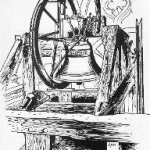 The early bells were rung by a number of men pulling on a lever. The three ton bell at Canterbury needed about twenty men; they would all strain and pull and raise it a little, and then let go. The bell would swing back, the clapper would hit and strike a note. For greater control, a wooden half circle with a rope was attached to the head stock. The pull of the rope turned the half wheel, and the bell swung with the half wheel. Control was minimal, but the bells could be rung in order. The first notes would be separated; then the sounds would jangle as the bells swung back and forth.
The early bells were rung by a number of men pulling on a lever. The three ton bell at Canterbury needed about twenty men; they would all strain and pull and raise it a little, and then let go. The bell would swing back, the clapper would hit and strike a note. For greater control, a wooden half circle with a rope was attached to the head stock. The pull of the rope turned the half wheel, and the bell swung with the half wheel. Control was minimal, but the bells could be rung in order. The first notes would be separated; then the sounds would jangle as the bells swung back and forth.
The definitive change that allowed real control occurred when a full wheel was attached to the headstock. Then if the bell is mouth up when the rope is pulled, the bell will fall and swing through a full 360 degrees and can come precisely to balance every time. The clapper will fall in different timing than the bell. As the bell rises on the other side, the clapper hits the bell edge. Thus a single note sounds. This is the present method of bellringing.
A swinging bell has properties in common with a pendulum. The timing cannot be easily changed. You cannot make a pendulum of fixed length swing faster without some forcing. Since each bell rings at a fixed rhythm which cannot be easily altered, tunes cannot be rung easily. However, eight bells (or six or ten or twelve) on the tonic scale can be pulled off one after another, to sound the eight notes on the descending scale, and then the first and following bells may be swung back in the other direction to sound like a sequence of eight notes. Thus the descending succession 12345678 — called rounds — can be repeated over and over at a fixed rhythm. This repeating sequence, a lovely cascading sound, accompanies English brides and grooms down the aisle after their vows.
However, even this dulls with repetition. Once a ringer has learned to handle a rope well — a process of several months — he or she can pull the rope so that the bell swings through 360 degrees and balances mouth up. The ringer whose bell follows immediately after can give the bell a lighter pull so that it doesn’t quite reach the balance point, and therefore rings sooner on the return or back stroke. In this way two bells can change places in the tone row (or change). In particular, if the person ringing the number one or treble bell (lightest and highest pitch) could attain the balance position and hold it while the number two bell is pulled down ahead of it, then bells one and two would have changed position. If each adjacent pair of bells changed places then the sequence 12345678 would be followed by 21436587.
It is not practical for a bell to move more than one position at a time. Balancing a bell is always tentative, and if the ringer moving ahead stopped the bell too far below the balance point, the bell would not rise sufficiently on the other side. Or if the bell is pulled too hard — in order to get it mouth upwards again — the bell might swing over the balance point, and the bell would bounce off the stay and come down too soon. Bashing the stay is very bad form. The presence of a non-broken stay on the bell prevents a ringer from accidentally being pulled up to the ceiling!
